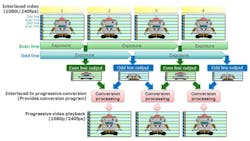High-speed video recording requires a high frame rate and short exposure time, which often results in underexposed images. Hoping to raise and even double exposure time, a new complementary-metal-oxide-semiconductor (CMOS) image-sensor technology adopts an interlaced video output as opposed to the standard progressive output used by current sensors. As a result, Toshiba claims that its Bright Mode technology allows smartphones and tablets to record full-high-definition (full-HD) video at 240 f/s while realizing high-quality, slow-motion video playback at one-eighth the standard speed.
Bright Mode utilizes charge binning, which doubles the electrical charge of each pixel. In doing so, it creates images four times brighter than those produced with previous CMOS sensors. To further improve image quality, reduce color noise, and deliver critical detail, the sensors use backside illumination (BSI), color noise reduction (CNR), and high dynamic range (HDR). BSI enables the formation of finer image pixels through a lens on the silicon substrate behind the sensor, which increases light sensitivity. CNR separates the image into low, middle, and high spatial frequencies, combining the components of each into a map that decreases color noise. For its part, HDR takes multiple pictures at different exposure levels, stitching them together to produce a picture with truer colors.
In tandem with the new sensors, Toshiba is providing an interlace-progressive conversion program that enables users to offer high-quality video with low deterioration and without changing frame rate. This technology development was inspired by the growing popularity of short-video-clip mobile applications and the need for improved video viewing.
About the Author
Iliza Sokol
Associate Content Producer
Iliza joined the Penton Media group in 2013 after graduating from the Fashion Institute of Technology with a BS in Advertising and Marketing Communications. Prior to joining the staff, she worked at NYLON Magazine and a ghostwriting firm based in New York.
